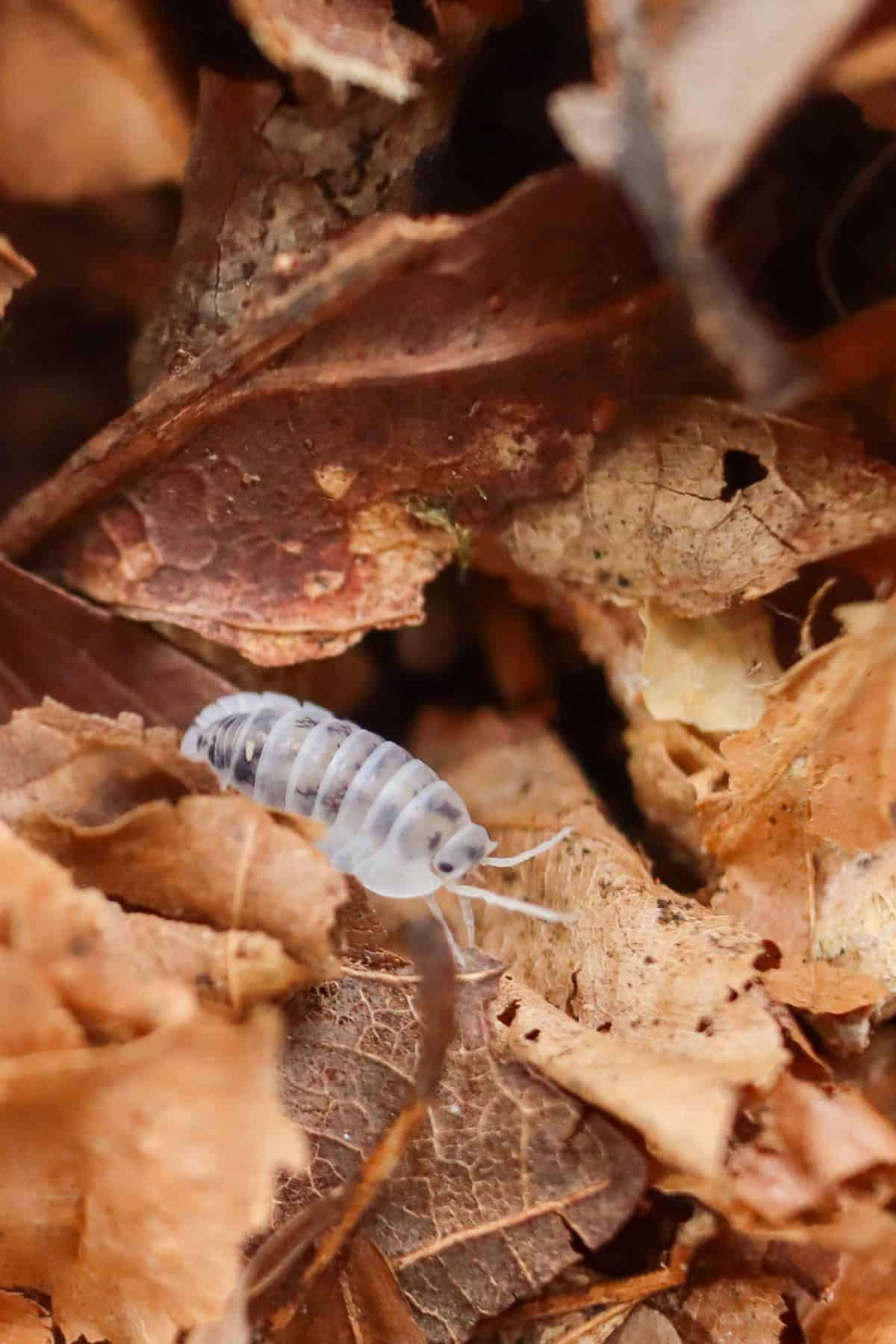Isopods in terrariums help break down organic matter and maintain a healthy ecosystem. They are popular among hobbyists for their beneficial roles.
Isopods, also known as “pill bugs” or “woodlice,” are small crustaceans that thrive in humid environments. They play an essential role in maintaining terrarium ecosystems by breaking down organic matter and recycling nutrients. These tiny creatures help control mold and reduce waste, making them invaluable for terrarium enthusiasts.
Isopods are easy to care for and can coexist peacefully with many other species. They come in various colors and sizes, adding both functionality and aesthetic appeal to terrariums. Including isopods in your terrarium setup can significantly enhance its health and longevity.

Credit: www.gulleygreenhouse.com
Introduction To Isopods
Isopods are tiny creatures that thrive in terrariums. They help maintain a balanced ecosystem. Isopods are fascinating and serve various essential roles in a terrarium.
What Are Isopods?
Isopods are small crustaceans with hard exoskeletons. They belong to the order Isopoda. Isopods have seven pairs of legs. They are often called woodlice or pill bugs.
These creatures are decomposers. They break down organic matter. This helps keep your terrarium clean and healthy. Isopods are also a source of food for some terrarium inhabitants.
Types Of Isopods
There are many types of isopods suitable for terrariums. Each type offers unique benefits. Here’s a table summarizing some popular types:
| Type | Size | Color | Special Features |
|---|---|---|---|
| Armadillidium vulgare | 10-18 mm | Gray | Rolls into a ball |
| Porcellio scaber | 11-15 mm | Gray or Brown | Very active |
| Porcellionides pruinosus | 8-12 mm | Blue or Purple | Fast breeder |
Armadillidium vulgare is known for rolling into a ball. Porcellio scaber is very active and moves quickly. Porcellionides pruinosus is a fast breeder and colorful.
- Armadillidium vulgare: Ideal for beginners.
- Porcellio scaber: Great for aerating soil.
- Porcellionides pruinosus: Adds color to your terrarium.
Choose the type that fits your terrarium needs. Each type offers different benefits.

Credit: terrariumtribe.com
Benefits Of Isopods In Terrariums
Isopods are a great addition to terrariums. They offer several benefits to the ecosystem. These tiny creatures are not only fascinating but also very useful.
Natural Cleaners
Isopods act as natural cleaners in your terrarium. They feed on decaying organic matter. This includes dead plants and animal waste. By doing this, they help keep the terrarium clean. This reduces the need for frequent cleaning by the owner. Isopods also help in breaking down this waste material. This makes it easier for plants to absorb nutrients. This creates a healthier environment for all terrarium inhabitants.
Soil Aeration
Isopods play a crucial role in soil aeration. They burrow through the soil, creating small tunnels. These tunnels allow air to reach plant roots. This improves the overall soil quality. Better soil aeration leads to healthier plants. Plants can absorb water and nutrients more effectively. This contributes to a thriving terrarium ecosystem.
Here’s a quick look at the benefits of isopods in terrariums:
| Benefit | Description |
|---|---|
| Natural Cleaners | They consume decaying organic matter and help reduce waste. |
| Soil Aeration | They create tunnels in the soil, improving air and water flow. |
In summary, isopods are essential for a thriving terrarium. They keep it clean and healthy.
Choosing The Right Isopods
Isopods are fascinating additions to terrariums. They help maintain a healthy ecosystem. But selecting the right species is crucial. This section will guide you through the process of choosing the right isopods for your terrarium.
Popular Species
Many isopod species are available for terrariums. Here are some popular choices:
- Armadillidium vulgare – Also known as the common pill bug.
- Porcellio scaber – Known for its hardiness and adaptability.
- Trichorhina tomentosa – Tiny and great for smaller terrariums.
- Powder Blue Isopods – Attractive with their blue coloration.
Factors To Consider
When selecting isopods, consider these factors:
| Factor | Description |
|---|---|
| Size | Choose isopods that fit your terrarium size. |
| Humidity | Some species need more humidity than others. |
| Temperature | Ensure the terrarium temperature matches the isopod’s needs. |
| Activity Level | Active isopods can be more entertaining. |
| Appearance | Some species have unique and attractive looks. |
By understanding these factors, you can make an informed choice. Happy isopods lead to a thriving terrarium.

Credit: www.reddit.com
Setting Up A Habitat
Creating the perfect habitat for isopods in your terrarium is essential. A well-set-up habitat ensures your isopods thrive. Below, we discuss the key elements to consider.
Substrate Choices
Choosing the right substrate is crucial for isopods. The substrate provides a place to burrow and lay eggs. Here are some popular choices:
- Coco Coir: Retains moisture well.
- Leaf Litter: Mimics natural habitat.
- Organic Soil: Nutrient-rich and natural.
Mixing substrates can provide the best environment. A combination of coco coir and leaf litter is ideal.
Humidity And Temperature
Isopods require specific humidity and temperature levels. Maintaining the correct levels is vital for their health.
| Condition | Ideal Range |
|---|---|
| Humidity | 60% – 80% |
| Temperature | 70°F – 85°F (21°C – 29°C) |
Use a hygrometer to monitor humidity levels. Misting the terrarium regularly helps maintain humidity.
A thermometer will help you keep track of the temperature. Ensuring these conditions will create a thriving environment for your isopods.
Feeding Isopods
Feeding isopods in terrariums can be a fun and rewarding task. Isopods are scavengers and enjoy a variety of foods. Proper nutrition keeps them active and healthy. Let’s explore their dietary needs and some supplement options.
Dietary Needs
Isopods require a balanced diet to thrive. They eat both plant and animal matter. Below is a table showing their common food sources:
| Type | Examples |
|---|---|
| Plant Matter | Leaf litter, wood, fruits, vegetables |
| Animal Matter | Dead insects, fish flakes, egg shells |
Leaf litter and wood are staples in their diet. You should provide them regularly. Fresh fruits and vegetables can be occasional treats. Avoid giving them too much protein-rich food.
Supplement Options
Supplements are essential for isopods to get all necessary nutrients. Here are some options:
- Calcium Supplements: Helps in building strong exoskeletons. You can use crushed eggshells or cuttlebone.
- Fish Food: Provides protein and essential minerals. Flake or pellet fish food works well.
- Leaf Litter: Not just food but also habitat. Make sure to use pesticide-free leaves.
By providing a mix of these supplements, your isopods will stay healthy and vibrant. Always ensure food is fresh and free of chemicals.
Maintaining Your Terrarium
Keeping a terrarium with isopods requires regular maintenance. This ensures a healthy environment for your isopods. Proper care can extend the life of your terrarium.
Regular Cleaning
Regular cleaning is essential for a thriving terrarium. Remove any dead leaves or uneaten food. This prevents mold and rot from developing. Use a small brush to clean the glass walls gently.
Check the substrate for waste buildup. Scoop out waste with a small scoop. Replace dirty substrate with fresh material. Ensure the substrate remains moist but not soggy.
Monitoring Health
Isopods are generally hardy creatures. Regular health checks are still important. Observe their behavior daily. Healthy isopods are active and move around.
Look for any signs of illness. These include discoloration or lethargy. Separate any sick isopods immediately. Consult an expert if the issue persists.
| Task | Frequency |
|---|---|
| Remove dead leaves | Weekly |
| Clean glass walls | Monthly |
| Check substrate | Bi-weekly |
| Health check | Daily |
Breeding Isopods
Breeding isopods in terrariums is a rewarding experience. These fascinating creatures are easy to breed and care for. Understanding their reproductive cycle and how to care for their offspring is crucial. This guide will help you successfully breed and raise isopods in your terrarium.
Reproductive Cycle
Isopods have a unique reproductive cycle. Female isopods carry their eggs in a pouch called a marsupium. The eggs hatch inside the pouch, and the young isopods, called mancae, emerge fully formed.
The breeding season for isopods can vary. In a controlled environment, they can breed year-round. Isopods reach maturity in about 3-4 months. They can live for up to 2 years, giving them ample time to reproduce.
To encourage breeding, maintain optimal conditions in the terrarium. This includes a temperature range of 70-80°F and high humidity levels. Provide plenty of food and hiding places for the isopods.
Caring For Offspring
Once the young isopods are born, they need special care. Ensure the terrarium environment remains humid and warm. High humidity helps the young isopods survive and grow.
Feed the young isopods a diet rich in organic matter. This can include decaying leaves, vegetables, and fruits. Avoid feeding them processed foods.
Provide adequate hiding spots for the young isopods. This can be in the form of small pieces of bark, leaves, or moss. These hiding spots offer protection and a place to rest.
Monitor the growth of the young isopods regularly. Remove any uneaten food to prevent mold growth. Keep the terrarium clean and free from harmful bacteria.
| Factor | Optimal Conditions |
|---|---|
| Temperature | 70-80°F |
| Humidity | High |
| Diet | Organic matter |
| Hiding Spots | Bark, leaves, moss |
With the right care, isopods will thrive and breed successfully in your terrarium. Follow these guidelines to ensure a healthy and vibrant isopod colony.
Troubleshooting Common Issues
Isopods in terrariums can be fascinating and beneficial. But sometimes, you may face issues that need troubleshooting. This section covers common problems and solutions.
Pest Control
Isopods can sometimes attract pests to your terrarium. Common pests include mites and fungus gnats.
- Mites: Remove any dead plant matter. Reduce humidity levels.
- Fungus Gnats: Use sticky traps. Avoid overwatering your terrarium.
If pests persist, consider introducing natural predators like predatory mites. They help keep pest populations in check.
Dealing With Overpopulation
Isopods can breed quickly. This can lead to overpopulation in your terrarium.
- Regular Monitoring: Check isopod numbers weekly.
- Controlled Feeding: Feed only what is necessary. Overfeeding leads to rapid breeding.
- Manual Removal: Remove excess isopods and relocate them to another setup.
Maintaining a balanced isopod population ensures a healthy terrarium ecosystem. Overpopulation can stress plants and other inhabitants.
Integrating Isopods With Other Species
Isopods add value to terrariums by helping with waste management. They break down organic matter and keep the environment clean. Integrating isopods with other species can create a balanced ecosystem. Learn how to ensure compatibility and maintain harmony in your terrarium.
Compatibility Factors
- Size: Ensure isopods are not prey for larger species.
- Habitat Needs: Match humidity and temperature requirements.
- Diet: Avoid species competing for the same food.
- Behavior: Choose non-aggressive animals to live with isopods.
Creating A Balanced Ecosystem
To create a balanced ecosystem, follow these steps:
- Research: Study the needs of all species in your terrarium.
- Setup: Prepare the terrarium with hiding spots and varied substrates.
- Monitor: Regularly check the health and behavior of all inhabitants.
- Adjust: Make changes to habitat conditions as needed.
Refer to the table below for an overview of species compatibility:
| Species | Compatibility with Isopods | Notes |
|---|---|---|
| Frogs | High | Share similar humidity needs |
| Lizards | Medium | Avoid large, predatory types |
| Snakes | Low | Snakes may eat isopods |
Conclusion
Isopods can enhance your terrarium’s ecosystem. They help with waste management and soil aeration. These small creatures are fascinating to observe. Including isopods can create a healthier environment for your plants and animals. Consider adding them to your terrarium for a thriving mini-ecosystem.
